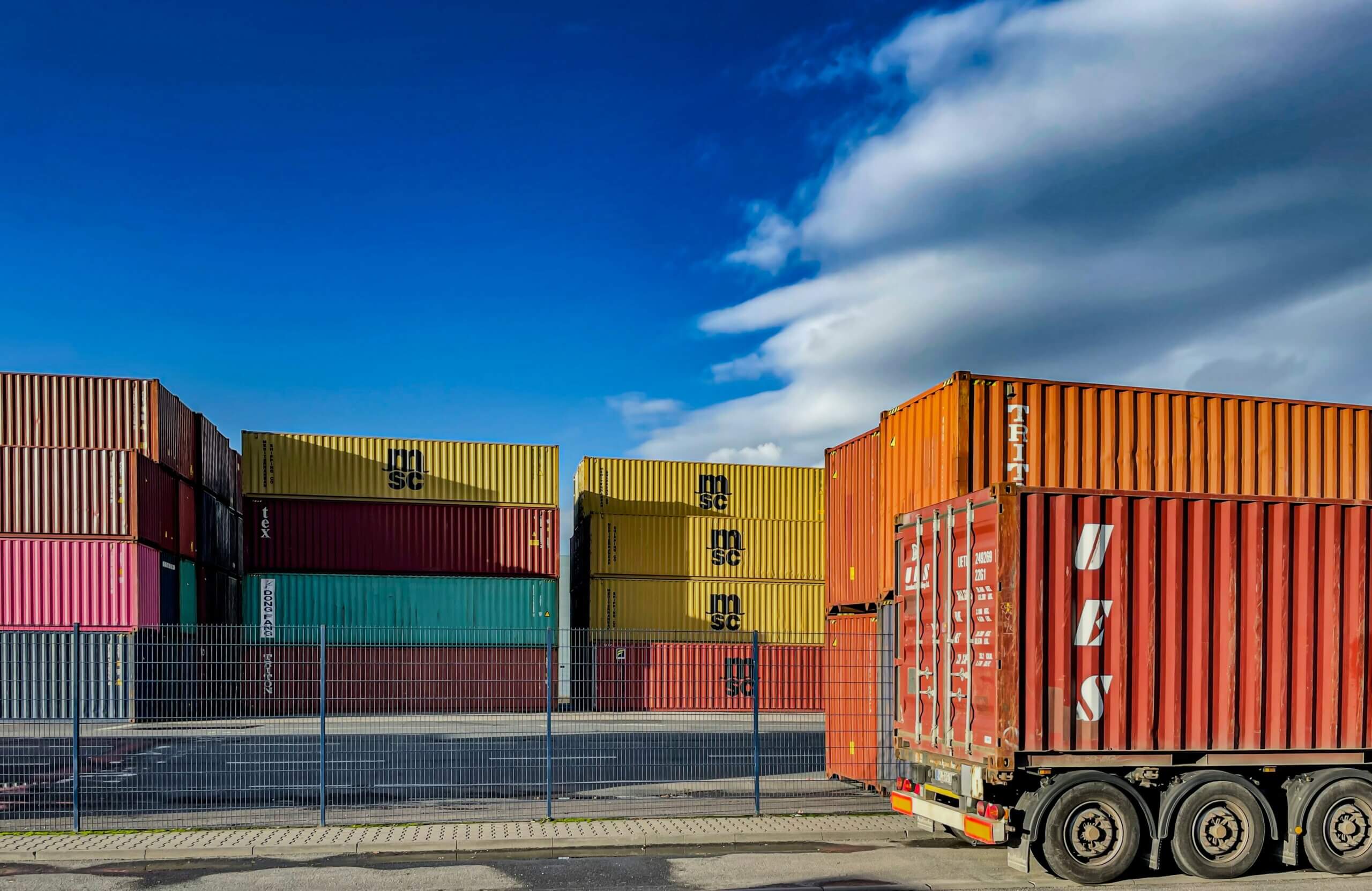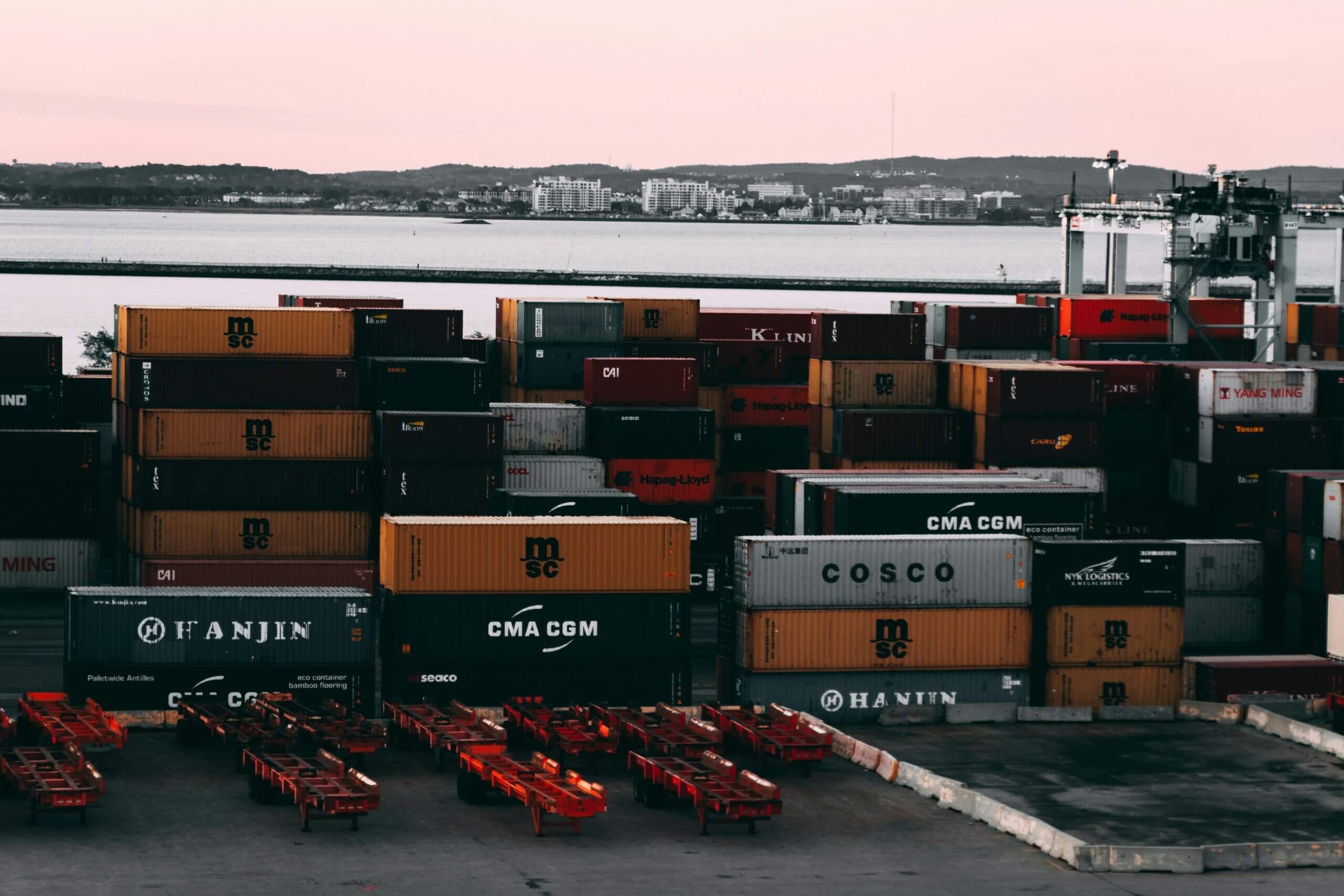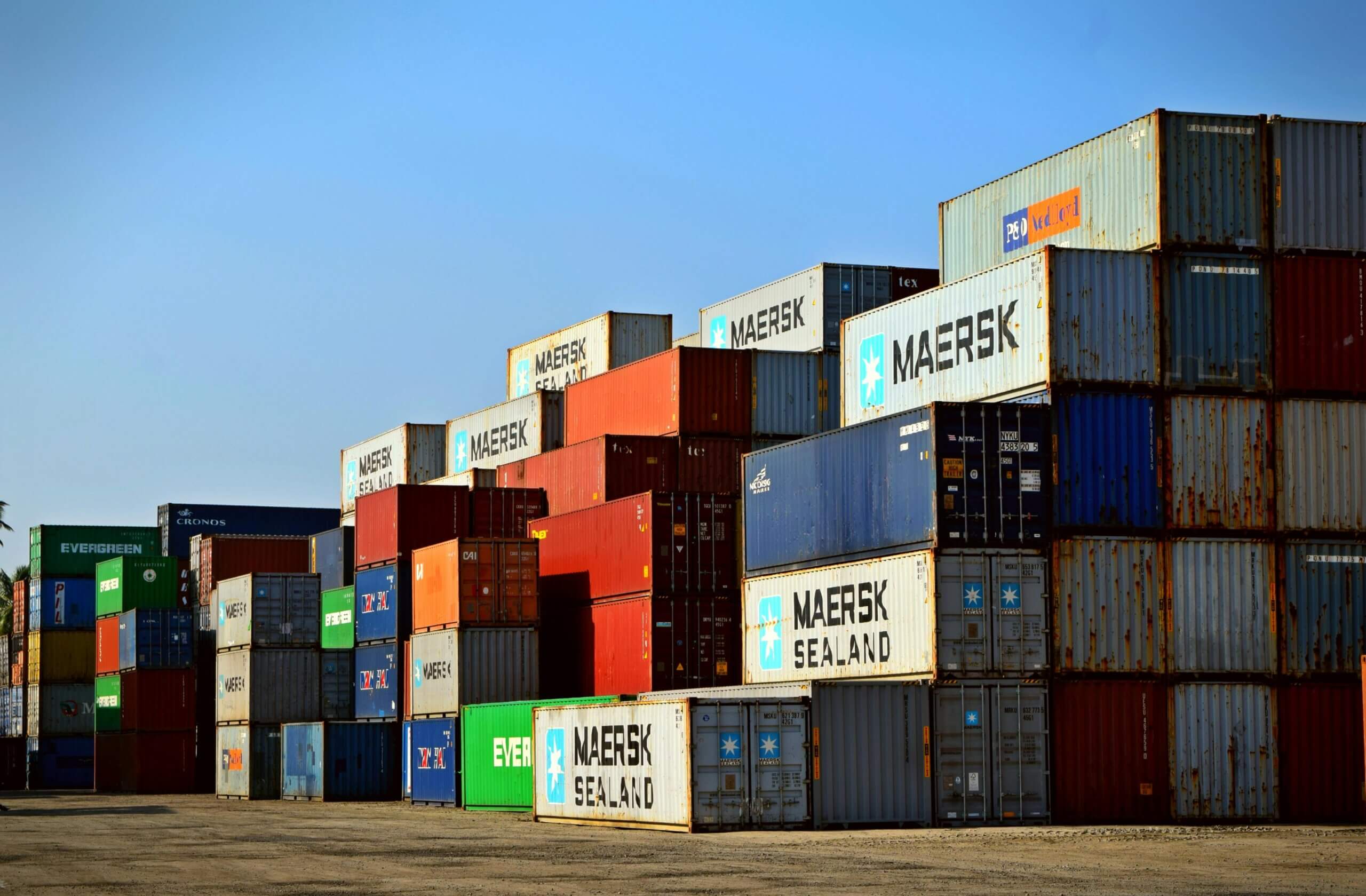Summary:
- While blank sailings were originally projected to surge, the announcement of a potential 100% tariff on Chinese imports resulted in a huge reduction in planned blank sailings in October. This is a result of the carriers adjusting to the influx of demand for inventory to be pulled forward in order to mitigate tariff exposure.
- Blank sailings surge on key regional lanes: US West Coast→Southeast Asia (+75%), China→US West Coast (+46.5%), Southeast Asia→US West Coast (+40.7%), US West Coast→Europe (+31.6%), Southeast Asia→US East Coast (+28.7%), and US West Coast→China (+26.5%), highlighting disruptions of U.S. imports and exports.
- Imports from China remain down for the 5th consecutive month, while exports remain down for the 9th consecutive months. Early data suggests some volumes shifting from China to Indonesia and Thailand as a source of U.S. imports.
- Early numbers show ecommerce on-time performance has not been impacted by the end of the de-minimis exemption. On-time performance improved by 1% between August and September.
Overview
The “Liberation Day” tariffs, which went into effect on August 7, 2025, represent the most wide-ranging tariff implementation in modern U.S. history. While sweeping in scope, they are only the latest in a series of tariff measures introduced this year. A wide range of duties, tracked in detail in our tariff tracker, has created an uncertain and often volatile environment for global trade.
One of the clearest indicators of this shifting landscape has been an increase in blank sailings throughout 2025, reflecting reduced demand for ocean capacity as the cost to import goods into the United States rises. These capacity cuts have been concentrated on certain lanes and carriers, particularly on U.S.-related trade routes most directly impacted by tariffs and geopolitical tensions. However, as tariff rates have begun to stabilize, early data suggests that U.S. companies have not made wholesale changes to their trade strategies. The overall proportions of imports and exports remain broadly consistent with 2024 levels year-to-date, indicating that for now, most sourcing patterns remain intact.
Some short-term tactical adjustments are evident. For example, Chinese weekly import volumes show both pull-forward ordering ahead of tariff hikes and delayed shipments when rates were at their peak. Yet on a net basis, U.S. import volumes are comparable to 2024, underscoring that the biggest changes so far have been in the timing of shipments rather than the structure of supply chains.
Longer-term shifts, such as moving manufacturing to other countries or reshoring production to the U.S., remain under close watch. These decisions require significant capital investment and multi-year timelines to execute. Until such changes materialize, the additional costs imposed by tariffs are being absorbed somewhere along the chain, whether by overseas vendors, U.S. importers, or ultimately, the end consumer.
Blank sailings data indicates shifting trade and capacity management
In 2025, blank sailings data illustrates how carriers are responding to tariff-driven disruption in U.S. trade. Several U.S.-related trade lanes have seen significant increases in blank sailing rates compared to 2024, pointing to tighter capacity control and shifting service priorities.
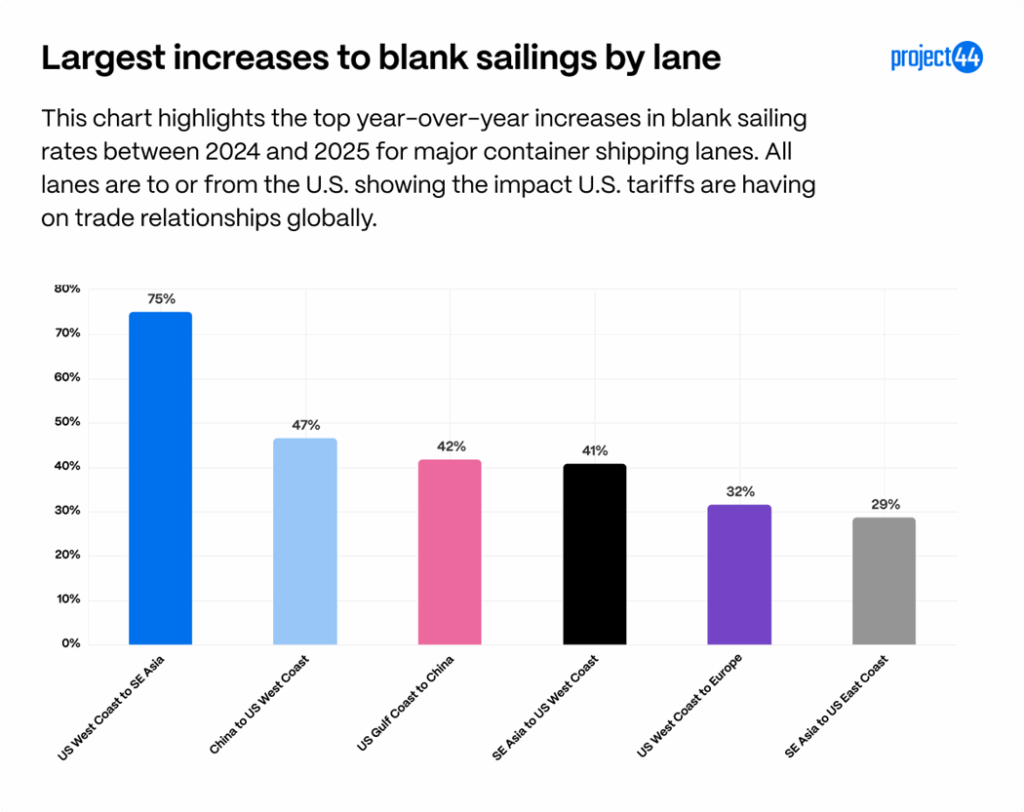
Year to date, the trans-Pacific, China to the U.S. West Coast saw a 46% jump in blank sailings year over year, while Southeast Asia to the U.S. West Coast recorded a 41% increase. These lanes remain among the heaviest trafficked in the world, and the surge in cancellations underscores how carriers are managing weaker U.S. import demand and adjusting for uncertainty created by ongoing tariff measures. The East Coast is not insulated either: Southeast Asia to the U.S. East Coast posted a 29% rise, reflecting pressure on all major Asia–U.S. corridors.
On the export side, lanes show even steeper proportional increases. Blank sailings from the U.S. West Coast to Southeast Asia climbed 75%, indicating that carriers are cutting capacity on U.S. export routes where tariffs, weaker demand for U.S. goods, and shifting trade flows are reducing vessel utilization. The U.S. Gulf Coast to China also emerged as a pressure point, suggesting that traditional energy and agriculture flows are being disrupted or rerouted as tariff impacts become more evident.
Taken together, the data shows that tariffs are driving a two-sided effect: carriers are blanking more sailings on Asia–U.S. import lanes to control rates, while simultaneously scaling back on U.S. export routes where demand has softened. The result is a broad-based rise in volatility across trans-Pacific and trans-Atlantic trade, with blank sailings now functioning as a primary lever for carriers to navigate the uncertainty introduced by shifting tariff policies. “Carriers are blanking sailings at an intensity we haven’t seen since the early pandemic period. The strategy is less about crisis response this time and more about maintaining rate stability in a tariff-distorted market.”, stated veteran supply chain analyst and former Gartner research leader Bart De Myunck.
Blank sailings between the U.S. and China continue to be a point of interest in global trade. Between January 2024 and late 2025, blank sailings on U.S.–China routes shifted from relatively stable patterns to sharp volatility.

Throughout 2024, monthly cancellations generally ranged from 10–32 per direction, a steady but manageable level. That dynamic changed in 2025: blank sailings spiked in April–June, surged again in September, and were originally expected to reach new heights in October 2025 at 67 (China→U.S.) and 71 (U.S.→China), a level that exceeds rates during the Covid-19 pandemic. These projections plummeted with news of new tariffs (+100%) on Chinese goods and heightened trade tensions between China and the United States. Volume is being pulled forward to mitigate exposure to potential additional tariffs, so carriers have adjusted so they are able to accomodate the volume. However, with the pulling forward of inventory planned for future months, it is likely this number will increase again as demand declines.
Despite tariff changes, trade with China has not rebounded
While tariffs on major trade partner China have been reduced in recent months, their effects continue to ripple through supply chains. A closer look at U.S./China trade flows in 2025 reveals sharp swings tied directly to tariff actions and market anticipation.
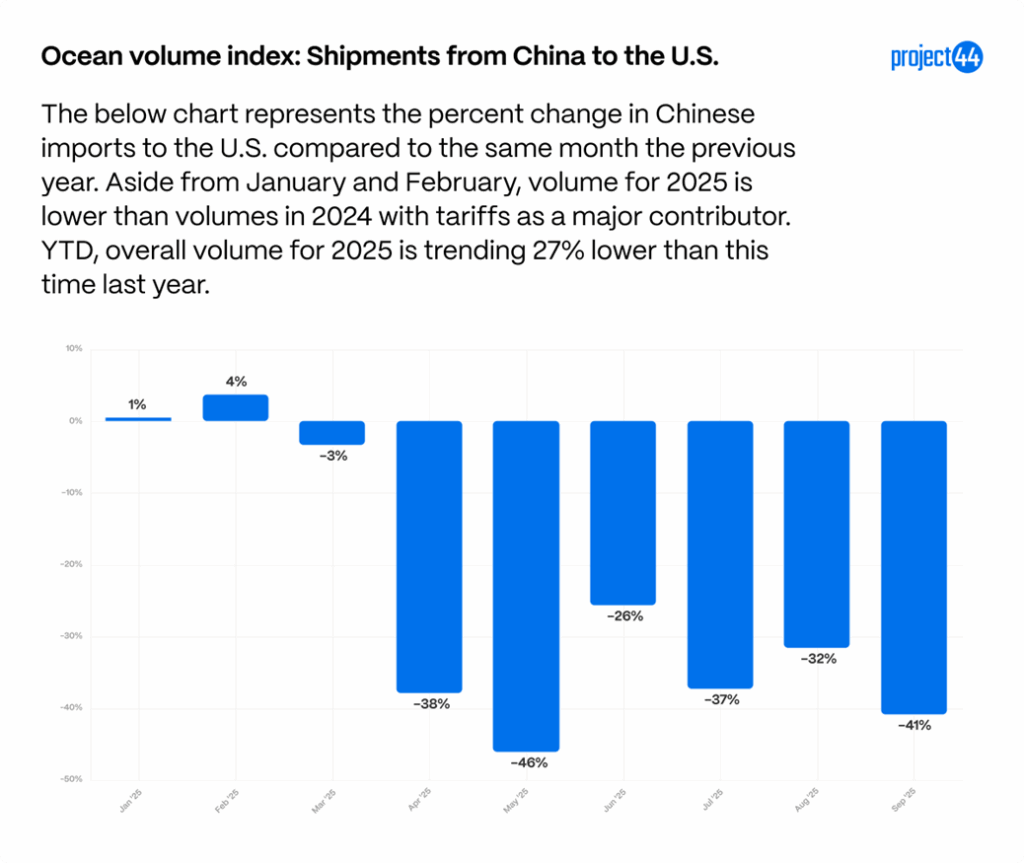
On the import side, shipments from China to the U.S. are trending 27% lower year-to-date compared to 2024. After modest gains in January (+1%) and February (+4%), volumes fell steeply, with declines of –38% in April, –46% in May, and –41% in September. These swings illustrate how tariffs and front-loading behavior created early-year spikes followed by sustained weakness through the summer and fall.
In response to the U.S. tariffs, China passed their own tariffs on U.S. goods, also impacting exports from the U.S. to China.

On the export side, shipments from the U.S. to China are under even greater pressure, trending 42% lower year-to-date. Monthly volumes have been consistently negative against 2024, with particularly steep drops of –57% in April, –53% in May, and –53% again in August. Political tensions layered on top of tariff measures are compounding the downturn, reducing demand for U.S. goods in the Chinese market.
It is abundantly clear that the new tariffs passed by both countries have had major impacts on demand for goods along these lanes.
Tariffs leave U.S. imports and exports proportionally unchanged
While tariffs have reshaped certain trade lanes, the broader proportions of U.S. imports and exports by country have seen only modest changes in 2025. This suggests that, despite political and economic headwinds, most U.S. companies have not significantly restructured their sourcing or customer base.
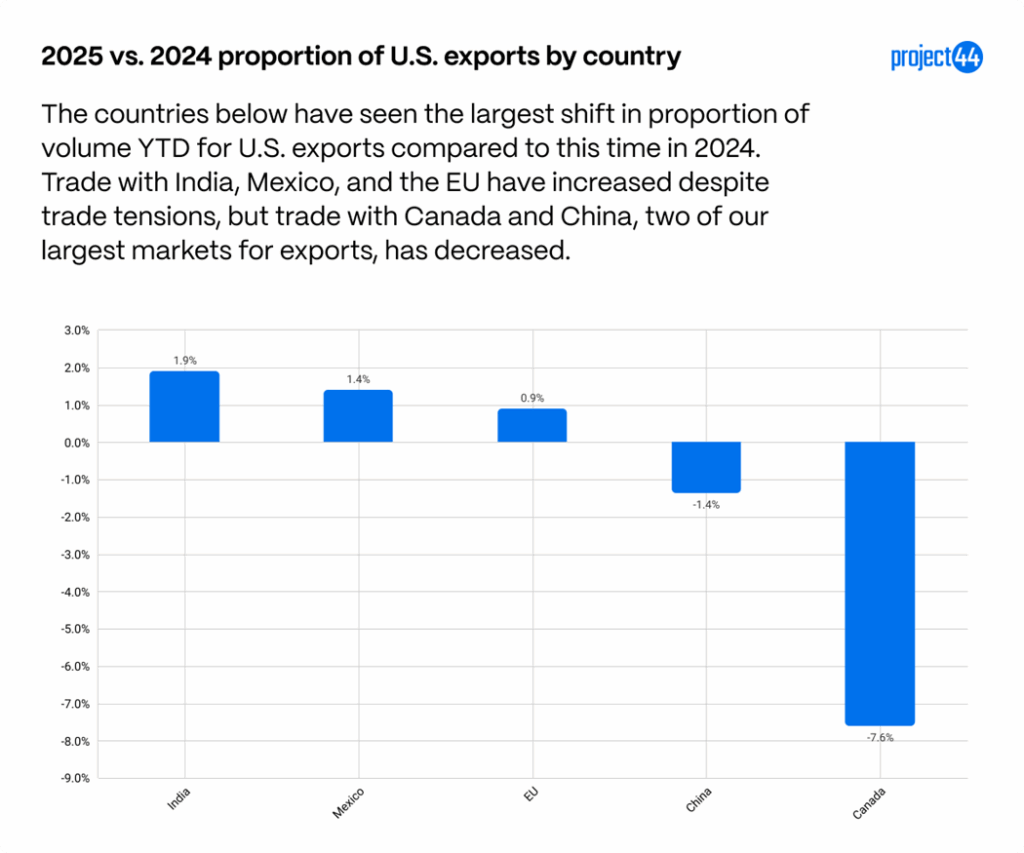
On the export side, Canada, one of America’s largest export partners, stood out for a steep 7.6% year-to-date drop in its share of U.S. exports. Political and economic tensions are high between Canada and the United States, which has resulted in “Buy Canadian” movements and impacted Canadian demand of some U.S. goods like alcohol, which could be a contributing factor to the lower rate the Canada is ordering U.S. goods. China is also seeing one of the largest decreases YTD at a 1.4% decrease. Meanwhile, India (+1.9%) and Mexico (+1.4%) have posted the largest proportional export gains, likely reflecting multi-year growth trends and ongoing diversification of U.S. export markets.

For imports, changes have been modest overall. India has recorded the largest year-over-year increase in share (+1.2%), followed by Bangladesh (+0.6%) and Japan (+0.5%), while the EU (-1.1%), Canada (-0.5%), and Indonesia (-0.5%) have all seen small declines. These shifts appear to reflect a broader trend toward supply chain diversification away from China, rather than a direct response to the 2025 tariff environment.
However, trade tensions with India are rising, and recent monthly data shows a small decline in the proportion of imports from India (-0.4% between August and September). This suggests that while India’s overall share remains higher than last year, short-term fluctuations and tariff pressures are beginning to weigh on shipments. India is currently subject to a 25% reciprocal tariff, an additional 25% tied to Russian oil imports, and potentially another 25% linked to Venezuelan oil, exposing Indian exports to tariffs ranging from 50–75%. The new 100% tariff on pharmaceuticals effective October 1, 2025, will further undermine competitiveness, pushing total tariff exposure for some Indian goods into the 150% range. If these trends continue, it is likely that the 1.2% increase in India’s proportion of U.S. imports will continue to decrease.
Notably, China’s share of U.S. imports remains essentially unchanged compared to 2024. While weekly data shows some volatility, especially around tariff hikes and subsequent reductions, the overall annual share has returned to last year’s baseline following an early-year surge from front-loaded orders.
Taken together, the data suggests that while tariffs and trade tensions are influencing short-term order timing and lane-level performance, they have yet to spark major structural shifts in U.S. trade patterns. Imports remain stable, with additional costs likely absorbed by vendors, importers, or end consumers, while exports show more signs of fluctuation as certain partners reassess their purchasing of U.S. goods.
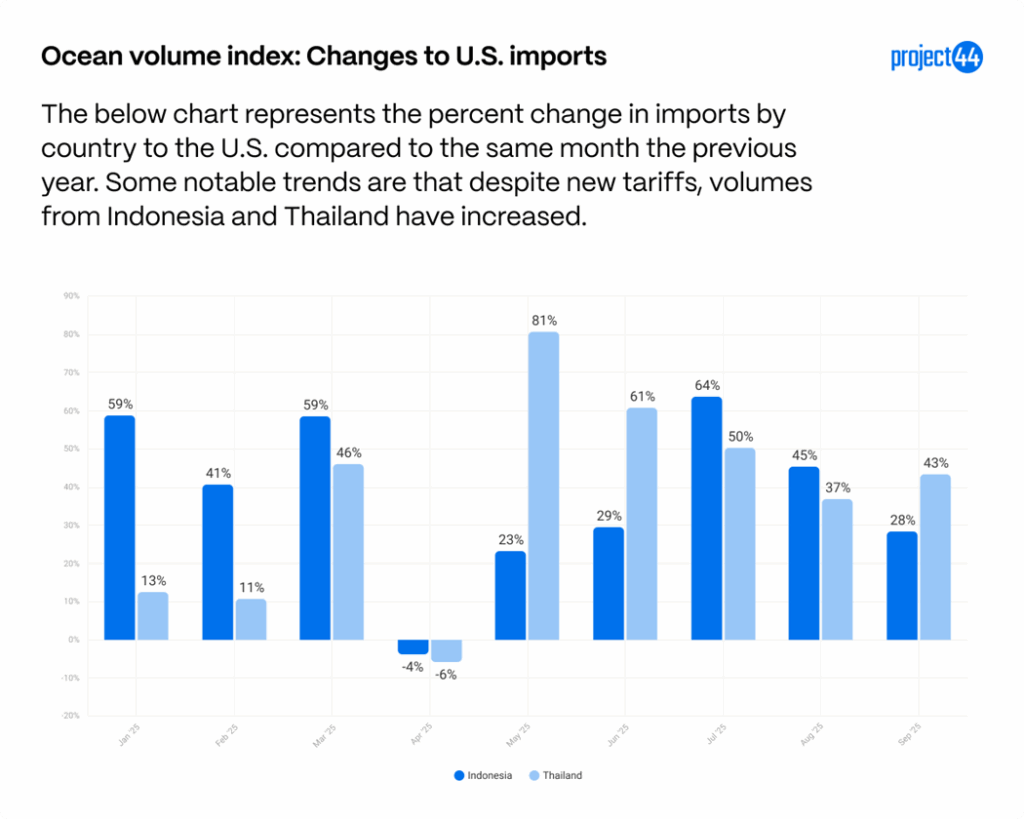
Ocean shipment data, however, reveals early signs of resourcing trends.
With volumes out of China decreasing, Indonesia and Thailand are emerging as alternative suppliers, showing monthly increases of 11–81% compared to 2024 (excluding April). Both countries still face tariffs (+19% since January, plus product-specific surcharges), but demand has nevertheless grown.
Impacts of the end of de minimis exemption
The de minimis exemption allowed packages entering the United States with a value of less than $800 to be exempt from tariffs and duties. This exemption was closed as of August 29, 2025, so now all items entering the U.S. are subject to tariffs and duties regardless of value. Shippers, like USPS, UPS, and FedEx are responsible for collecting these taxes, and charge broker fees to cover processing costs and labor needed to manage this process. This has led to an uptick in consumers in the U.S. being surprised by a tariff bill after a package was delivered and has created a need for an average consumer to have a higher awareness for where online orders are shipping from and what tariffs and duties they might incur.
This has also led to an increase in work needed for ecommerce shippers to process shipments from overseas, with concerns that this will delay online orders in the ecommerce space.
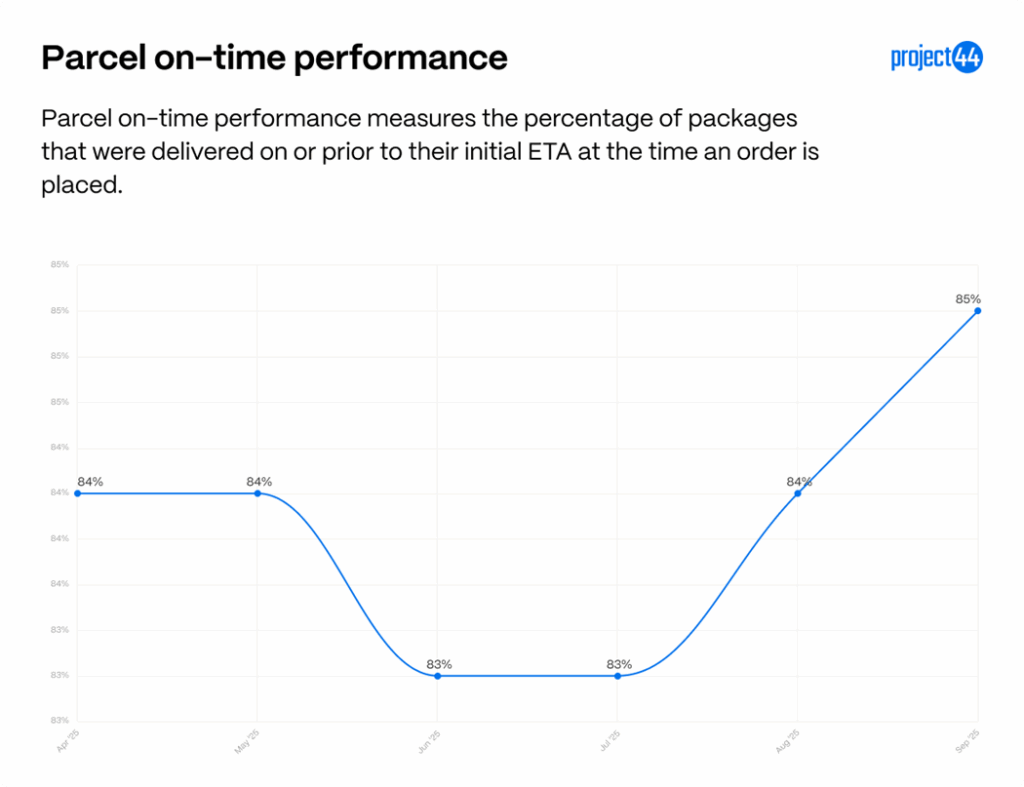
Despite the end of de minimis, last-mile on-time performance improved by 1% between August and September. This does not mean packages aren’t facing delays due to the extra paperwork and processing required for imports, but rather reflects that many retailers fulfill ecommerce orders domestically. Major retailers often import in bulk, stock fulfillment centers, and ship domestically, so most online orders in the U.S. are unaffected.
However, consumers should be aware of a package’s origin, as items shipped directly from overseas remain subject to tariffs, duties, and potential delays.
Appendix
These charts are made to serve as a baseline to fully understand the scope of tariffs and shifting trade dynamics. According to data from the millions of shipments managed annually by project44, the United States primarily imports goods from the following top countries by volume:
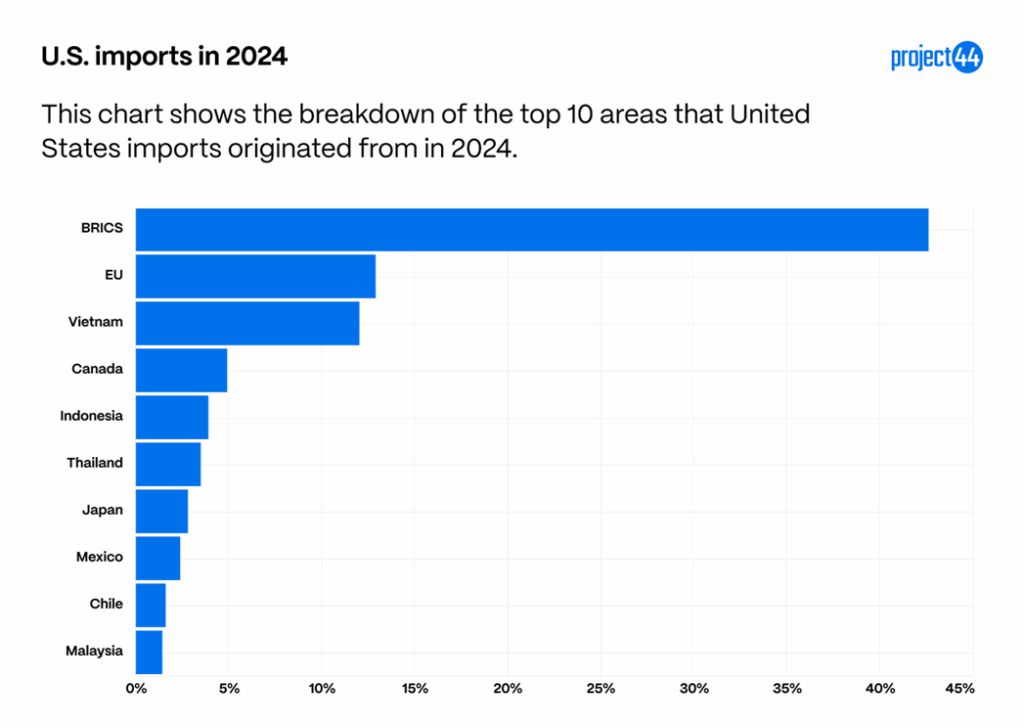
China, which is included in the BRICS category, is our largest provider of imports, followed by the EU and Vietnam. These three regions make up more than 50% of the imports tracked by project44 in 2024.
Below are the countries that see the most American exports based off project44 data.
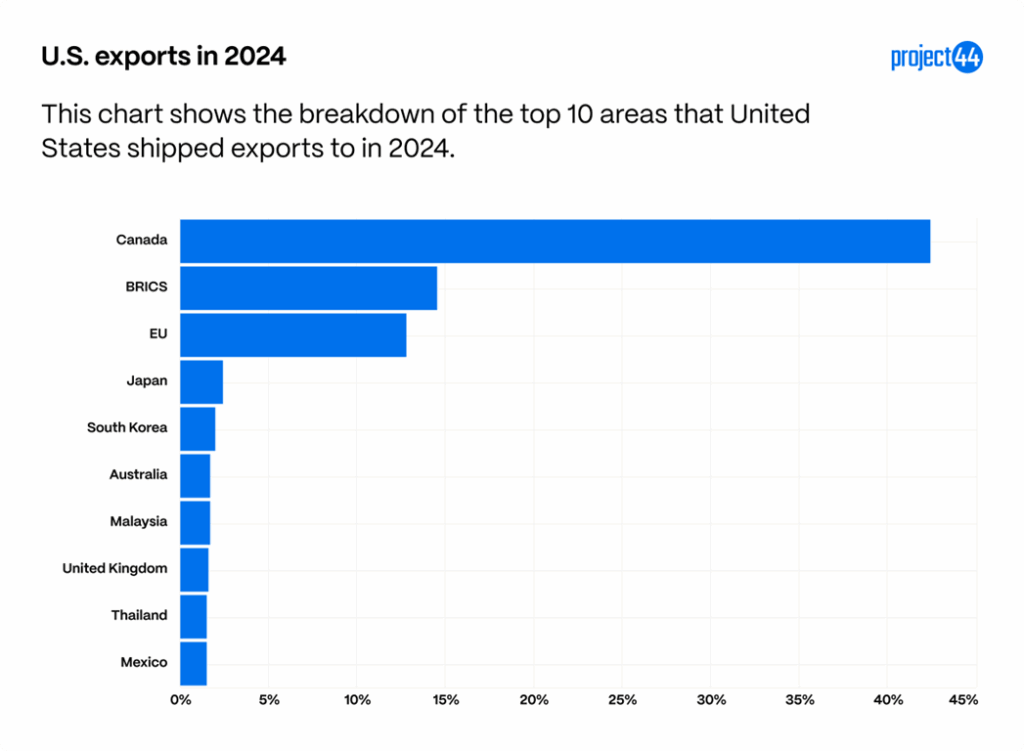
With China separated from the BRICS nations, they receive 8.5% of exports, meaning Canada, China, and the EU make up more than half of the shipments exported from the United States in 2024.
Summary
Overall, the 2025 tariff environment has introduced significant volatility into U.S. trade, with blank sailings rising sharply across key lanes and U.S.–China trade flows experiencing some of the steepest declines on record. Imports from China are trending 27% below 2024 levels, while exports to China are down 42% year-to-date, underscoring the depth of the disruption. Yet despite these sharp swings, the broader structure of U.S. trade remains largely intact, with most sourcing and export relationships holding steady outside of China. For now, tariffs are influencing the timing and reliability of shipments more than the geography of supply chains, though ongoing political and economic uncertainty leaves the outlook for 2026 highly contingent on future tariff decisions and trade negotiations.
